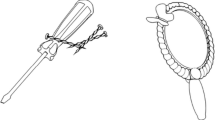Abstract
The problem-solving performance of young boys and girls was examined in three conditions in which good performance was indicated as being appropriate for boys, for girls, or for both boys and girls. The relations between task scores and five sex-role measures were also examined. As predicted, the boys performed significantly more poorly when the task was indicated as one that girls did better. The girls' performance was not affected by the conditions of the study. The girls' problem-solving scores did not differ significantly from the boys' scores. There was some relationship between the task scores and the sex-role measures for boys, but not for girls. Associations among the sex-role measures were not high.
Similar content being viewed by others
References
Brown, D. G. Sex-role preference in young children. Psychological Monographs, 1956, 70 (14, Whole No. 421).
Dunn, L. M. Peabody Picture Vocabulary Test. Circle Pines, Minn.: American Guidance Service, Inc., 1959.
Fein, G., Johnson, D., Kosson, N., Stork, L., & Wasserman, L. Sex stereotypes and preferences in the toy choices of 20-month-old boys and girls. Developmental Psychology, 1975, 11, 527–528.
Goodenough, F. L., & Harris, D. G. Goodenough-Harris drawing test. New York: Harcourt, Brace & World, Inc., 1963.
Guilford, J. P. Creativity tests for children: A manual of interpretation. Beverly Hills, Calif: Sheridan Psychological Services, 1971.
Hartley, R. E. Some implications of current changes in sex role patterns. Merrill-Palmer Quarterly of Behavior and Development, 1960, 6, 153–164.
Hoffman, L. R., & Maier, N. R. F. Sex differences, sex composition and group problem solving. Journal of Abnormal and Social Psychology, 1961, 63, 453–456.
Kagan, J. Acquisition and significance of sex typing and sex role identity. In M. L. Hoffman & L. W. Hoffman (Eds.), Review of child development research (Vol. 1). New York: Russell Sage, 1964. Pp. 137–167.
Kagan, J., & Lemkin, S. The child's differential perception of parental attributes. Journal of Abnormal and Social Psychology, 1960, 61, 440–447.
Liebert, R. M., McCall, R. B., & Hanratty, M. A. Effects of sex-typed information on children's toy preferences. Journal of Genetic Psychology, 1971, 119, 133–136.
Lynn, D. G. Parental and sex role identification: A theoretical formulation. Berkeley: McCutchan Publishing Corp., 1969.
McGhee, P. E. Television as a source of learning sex role stereotypes. Paper presented at the meeting of the Society for Research in Child Development, Denver, April 1975.
Milton, G. A. The effects of sex-role identification upon problem-solving skill. Journal of Abnormal and Social Psychology, 1957, 55, 208–212.
Mischel, W. Sex-typing and socialization. In P. H. Mussen (Ed.), Carmichael's manual of child psychology. New York: John Wiley & Sons, Inc., 1970. Pp. 3–72.
Montemayor, R. Children's performance in a game and their attraction to it as a function of sex-typed labels. Child Development, 1974, 45, 152–156.
Nadelman, L. Sex identity in American children: Memory, knowledge and preference tests. Developmental Psychology, 1974, 10, 413–417.
Reis, M. The relation of parental availability to problem solving and sex-role orientation in the young boy. Unpublished master's thesis, Concordia University, Montreal, 1976.
Rosenberg, B. G., & Sutton-Smith, B. A revised conception of masculine—feminine differences in play activities. Journal of Genetic Psychology, 1960, 96, 165–170.
Slaby, R. G., & Frey, K. S. Development of gender constancy and selective attention to same-sex models. Child Development, 1975, 46, 849–856.
Stein, A. H., Pohly, S. R., & Mueller, E. The influence of masculine, feminine and neutral tasks on children's achievement behavior, expectancies of success, and achievement values. Child Development, 1971, 42, 195–207.
Author information
Authors and Affiliations
Additional information
This research was supported by a DGES-FCAC research grant from the government of Quebec, Canada.
Rights and permissions
About this article
Cite this article
Gold, D., Berger, C. Problem-solving performance of young boys and girls as a function of task appropriateness and sex identity. Sex Roles 4, 183–193 (1978). https://doi.org/10.1007/BF00287499
Issue Date:
DOI: https://doi.org/10.1007/BF00287499




